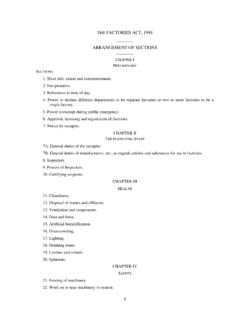Transcription of The Collaborative Problem Solving Approach: Outcomes …
1 The Collaborative Problem Solving Approach: Outcomes Across SettingsAlisha R. Pollastri, PhD, Lawrence D. Epstein, PhD, Georgina H. Heath, BSc,and J. Stuart Ablon, PhDIn the last decade, Collaborative Problem Solving (CPS) has become a popular approach to managing the challengingbehaviors of children and adolescents, and has established a growing evidence base for reducing oppositional behav-ior and related Outcomes . In contrast with standard behavioral methods that provide incentives for meeting adultexpectations, CPS focuses on identifying and treating lagging cognitive skills that interfere with children s ability tomeet these expectations. Since the majority of CPS Outcomes have been evaluated in clinical and educational settingsas part of internal quality-improvement efforts, only a small proportion of thesefindings has been published in peer-reviewed academic journals.
2 Here, we describe the CPS approach and provide a summary of all known publishedand unpublishedfindings related to its implementation in outpatient, inpatient, residential, juvenile justice, and edu-cational settings. Finally, we provide specific recommendations for future research on the :children, Collaborative Problem Solving , externalizing, family, inpatient, juvenile justice, oppositionaldefiant disorder, residential, school, Think KidsExternalizing behaviors, including temper outbursts,defiance, deceit, destruction of property, and verbalor physical aggression are relatively common in chil-dren, with 5% to 13% of mothers of preschoolers reportingthat their children exhibit moderate to severe externalizingbehaviors,1 3and epidemiologic studies reporting a 19%lifetime prevalence of childhood disruptive behavior exhibiting externalizing behaviors are fre-quently referred to as oppositional, challenging, explosive,difficult, defiant, or aggressive.
3 They may carry diagnosesof attention-deficit/hyperactivity disorder (ADHD), conductdisorder (CD), oppositional defiant disorder (ODD), or inter-mittent explosive disorder, or these challenging behaviorsmay be one part of a larger set of symptoms identified as amood, anxiety, or developmental negative impact of children s externalizing symp-toms on their caregivers and the community is example, parents of externalizing children often experi-ence clinically significant levels of stress,5and studentmisbehavior is consistently identified as a primary sourceof teacher 8 This stress is exacerbated when tea-chers are not adequately trained or have insufficientresources available to work effectively with , managing challenging behaviorcan cause a strain on both the relationships and interac-tions between children and adult.
4 11 Consider-ing the individual and familial costs of externalizingbehaviors, as well as societal costs associated withgovernment-subsidized juvenile detention centers, spe-cialized school programs, residential facilities, inpatientpsychiatric units, and outpatient community agencies, itis no surprise that significant research has been devotedto evaluating the efficacy of interventions targeted at re-ducing these and educational settings that specialize in treat-ing disruptive behavior disorders have historically usedmethods of intervention that are based on operant theoriesof behavior methods, including pointand level systems, quiet rooms, physical restraints, andseclusion, are typically believed to help patients developgreater self-control and coping, to increase positive behavior,and to decrease negative and aggressive , the efficacy of some of these behavioral methods hasrecently been called into 17Of particular concern recently has been the use of phys-ical restraint and seclusion in managing externalizing be-havior.
5 First, there is growing evidence that restraint andseclusion procedures may actually heighten aggressive be-havior in , these procedures can be dan-gerous for both the patients and staff involved18,19and, inFromHarvard Medical School (Drs. Pollastri, Epstein, and Ablon); Depart-ment of Psychiatry, Massachusetts General Hospital, Boston, MA ( , Epstein, and Ablon); St. Andrew s Healthcare, Northampton, UK(Ms. Heath).Original manuscript received30 October 2012; revised manuscript re-ceived 12 March 2013, accepted for publication 8 April :Alisha R. Pollastri, Department of Psychiatry, Massachu-setts General Hospital, 55 Fruit St., Boston, MA 02114. Email: 2013 President and Fellows of Harvard CollegeDOI: 21 Number 4 July/August 2013 Copyright @ 2013 President and Fellows of Harvard College.
6 Unauthorized reproduction of this article is extreme cases, have led to ,21As a result, leg-islation has been introduced with the goal of reducing oreliminating these types of restrictive ,23In-terestingly, while the motivation to reduce the use ofrestrictive interventions has been to improve educationaland mental health services, one analysis in a single inpatientagency found an annual cost savings of over $1 millionresulting from the decreased use of physical, mechanical,and medication-based , decreasing use ofrestrictive interventions may make sense not only from apsychological, but also from an economic, to the potential for tragic Outcomes related to re-strictive behavioral interventions, the last decade has seen amovement away from these traditional behavioral practicesand toward the development of alternative methods thatpose fewer risks to staff and patients and that effectivelydecrease externalizing behaviors.
7 One of these new approachesisCollaborative Problem Solving (CPS). As described by Greene and J. Stuart Ablon in their treatment manual,25the CPS model reconceptualizes the reasons for children s exter-nalizing behaviors, and offers specific techniques for interven-tion. The CPS approach has been implemented in a variety ofoutpatient, inpatient, residential, juvenile justice, and schoolsettings, and there have been multiple formal and informalattempts to evaluate and validate this treatment this article, we first describe how CPS differs fromconventional approaches in conceptualizing and treatingexternalizing disorders in children. Next, we summarizeall known published and unpublished evaluations of thetreatment model from the time of its introduction upthrough 2012.
8 Finally, we make recommendations for fu-ture comprehensive evaluation of the CPS model, with theultimate goal of improving the treatment of childhood ex-ternalizing INTERVENTIONS FOREXTERNALIZING BEHAVIORS: OPERANTAPPROACHESThe procedures and tools that are typically used to reduceoppositional behavior are based upon common beliefsabout its causes. Behavioral theories suggest that childrenlearn to behave disruptively because those behaviors effec-tively get them something ( , attention) or allow them toavoid something ( , work). This understanding assumesthat children have control over whether they behave incompliance with, or in opposition to, adult understanding also implies that these children will be-have well if they believe that good behavior will result ina desired outcome .
9 Consistent with this theory, many com-mon interventions for disruptive behavior aim to motivateoppositional children towant tobehave better. In sum,behavioral theories posit that children will do well ifthey want to, and corresponding interventions aim toincrease children s motivation such that they will wantto behave on this understanding, many conventional behav-ioral interventions with externalizing children have soughtto motivate compliant behavior through operant methods date back to the famous behaviorist studiesof B. F. Skinner (1904 90), who demonstrated that targetbehaviors could be elicited, and unwanted behaviorsdiminished, through an intensive and consistent menu ofrewards and punishments. Behavioral approaches, includ-ing reward charts and time-outs, are now used worldwideand are applied in a wide range of settings.
10 Indeed, consid-erable empirical research supports a number of treatmentapproaches that use operant behavioral methods to in-crease compliance with adult approaches typically achieve two primaryobjectives related to the management of behavior. First,they reinforce basic lessons, such as what the acceptableand unacceptable behaviors are in a given situation. Sec-ond, they facilitate extrinsic, or external, motivation. Themotivation to receive a reward or avoid a punishment cantip the scales in favor of exhibiting a desired behavior,assuming one has the skills needed to perform that behav-ior. As an example, a recent meta-analysis suggests thatconventional behavioral approaches can be moderatelysuccessful in decreasing externalizing behavior, thougheffect sizes are not as robust as once assumed,27and posi-tive effects may not be sustained in the long ,16,28 While behavioral methods are useful in some cases, pro-blems arise when attempting to use these operant approacheswith children who know what is expected of them and whoare motivated to do well, but who lack skills to do so dueto deficits in impulse control, frustration tolerance, flexibil-ity, Problem Solving , or other adaptive skills.



